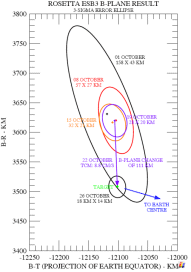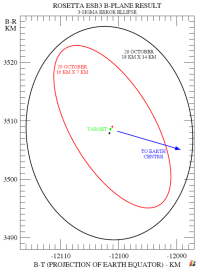No. 122 - Earth swingby preparations
On DoY 297 a set of tests was completed with the support of the New Norcia ground station, to characterise the performance of Rosetta's Telemetry, Tracking & Commanding system in locking the uplink signal in S-band via the spacecraft's low gain antenna (LGA). These tests help determine the uplink power level required to command the spacecraft's hibernation entry in June 2011. A further test will be performed in January 2010 with a DSN 70m antenna when the Deep Space Hibernation Mode (DSHM) will be tested.
Mission operations have been conducted with support of the ESA New Norcia (NNO) ground station. In addition several tracking passes with the NASA DSN ground stations Goldstone (DSS-24) and Madrid (DSS-54) were taken in support of the Earth swingby navigation campaign.
| DOY | Date | Pass | Main Activity |
| 290 | 17/10/09 | NNO 2060 |
Monitoring pass |
| 291 | 18/10/09 | NNO 2061 |
Monitoring pass |
| 292 | 19/10/09 | DSS-24 2062 |
Monitoring pass |
| 293 | 20/10/09 |
DSS-24 2063 |
Monitoring pass |
| 294 | 21/10/09 |
DSS-24 2064 |
Monitoring pass |
| 295 | 22/10/09 |
DSS-24 2065 |
Monitoring pass |
| 296 | 23/10/09 |
DSS-24 2066 |
Monitoring pass |
| 297 | 24/10/09 | DSS-24 2067 NNO 2067 |
Monitoring pass |
| 298 | 25/10/09 | DSS-54 2069 |
Monitoring pass |
| 299 | 26/10/09 |
DSS-24 2069 |
Monitoring pass |
| 300 | 27/10/09 |
NNO 2070 |
Re-lubrication of reaction wheel B Monitoring pass |
| 301 | 28/10/09 | NNO 2071 DSS-54 2072 |
Monitoring pass |
| 302 | 29/10/09 | DSS-24 2072 NNO 2072 |
Monitoring pass |
| 303 | 30/10/09 | DSS-24 2073 NNO 2073 |
Monitoring pass |
At the end of the reporting period (DoY 303) Rosetta was at 11.7 million km from Earth (0.078 AU) and the one-way signal travel time was 39 seconds. The distance to the Sun was 158.7 million km (1.06 AU).
Navigation Campaign
On 13 November 2009 Rosetta will perform its third Earth swingby. It is the mission's fourth and final gravity assist that will boost Rosetta's orbit to place the spacecraft on a trajectory to its final destination: comet 67P/Churyumov-Gerasimenko. Closest approach to Earth is expected to occur at around 07:45:40 UTC, with Rosetta passing at an altitude of about 2481 km.
The navigation campaign leading up to the swingby is proceeding nominally. The flight dynamics team at ESOC determines what, if any, course adjustments need to be made. Information on Rosetta's current inbound trajectory comes from telemetry transmitted by Rosetta and from Doppler and ranging data received from the ESA and NASA ground stations that are tracking the spacecraft regularly.
Based on this data any required adjustment to the spacecraft's velocity vector is determined. To place Rosetta on the correct approach trajectory for the Earth swingby four slots were reserved for possible trajectory control manoeuvres (TCMs): at 3 weeks, 8 days, 1 day and 6 hours before closest approach.
Trajectory Correction Manoeuvre
On 22 October the primary trajectory correction manoeuvre (at 3 weeks before closest approach) was successfully performed. Rosetta's four 10N axial thrusters were fired for 86 seconds. The achieved change in the spacecraft's velocity vector was very close to nominal, with a delta-V of 8.8 cm/s. The successful and accurate execution of the primary TCM means that currently no further TCM is foreseen at any of the three remaining possible slots.
The two figures below are B-plane plots illustrating the status of the navigation campaign in preparation for the third Earth swingby, after the TCM of 22 October. The B-plane is a planar coordinate system that allows targeting during a gravity assist. The target point of Rosetta's approach trajectory relative to the Earth in the B-plane is marked green in the plots below. Note: this is not the point of closest approach. Instead this virtual point corresponds to what would be Rosetta's miss-distance if the Earth had no gravity.
The navigation error ellipses are indicated based on radiometric data up to 26 October (left) and up to and including 29 October (right).
 |
 |
|
B-plane plot for Rosetta's third Earth swingby with the navigation results and error ellipses up to 26 October (left, in black) and up to and including 29 October (right, in red, 10× zoom) | |
Spacecraft
Payload
All instruments are OFF. The Standard Radiation Environment Monitor (SREM) continues to run in the background.
ALICE
The instrument is currently OFF.
CONSERT
The instrument is currently OFF.
COSIMA
The instrument is currently OFF.
GIADA
The instrument is currently OFF.
MIDAS
The instrument is OFF.
MIRO
The instrument is currently OFF.
OSIRIS
The instrument is OFF.
ROSINA
The instrument is OFF.
RPC
The instrument is OFF.
RSI
The instrument is muted.
VIRTIS
The instrument is currently OFF.
LANDER Philae
The instrument is currently OFF.
On DoY 300 the instrument contributed to the analysis of reaction wheel B performance by acquiring data with the CASSE accelerometers.
SREM
Since DoY 251/2009 the accumulation settings are configured for active cruise mode.
Future Milestones
The navigation campaign for the spacecraft's approach to the third and last Earth swingby will continue up to Rosetta's closest approach to Earth on 13 November. The current status after the TCM on 22 October is such that no other TCM is foreseen, but the reserved TCM slots do remain available at 8 days, 1 day, and 6 hours before closest approach.
Several of Rosetta's instruments will be activated between 6 and 9 November as part of the science observation campaign to be carried out during the Earth swingby phase.
---
Legal disclaimer
This report is based on the ESOC mission operations report, WOR #122. Please see the copyright section of the legal disclaimer (bottom of this page) for terms of use.


